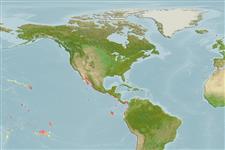>
Gobiiformes (Gobies) >
Microdesmidae (Wormfishes) > Ptereleotrinae
Etymology: Ptereleotris: Greek, pteron = wing, fin + The name of a Nile fish, eleotris (Ref. 45335); carinata: Name from Latin 'carina' for keel, 'carinata' meaning keeled; referring to the distinct membranous keel extending beneath the head..
Environment: milieu / climate zone / depth range / distribution range
Ecologia
marinhas demersal; intervalo de profundidade 12 - 25 m (Ref. 75966). Tropical
Eastern Pacific: Mexico (Gulf of California), Costa Rica and Panama.
Tamanho / Peso / Idade
Maturity: Lm ? range ? - ? cm
Max length : 8.3 cm SL macho/indeterminado; (Ref. 75996)
Descrição breve
Morfologia | Morfometria
Espinhos dorsais (total): 7; Raios dorsais moles (total): 20-22; Espinhos anais 1; Raios anais moles: 20 - 23. This species is distinguished from its congeners by the following characters: a short dorsal-fin (VI-I,20-22), first and second dorsal fins of about equal height; short anal-fin (I,19-22);isthmus with a conspicuous median fold or keel; caudal fin lanceolate with a dusky band on lower caudal rays in adults; a blue or lavender body without other markings (Ref. 75966).
The western Atlantic form, Ptereleotris calliurus, is similar to P. carinata in its more lanceolate tail with dark lower half, but differs from P. carinata in having a variety of other fin markings (vs. absent).
Individuals were seen poised 10-20 cm above small mounds encircling the small openings to their burrows. It was also observed in burrows always close to a reef or grouped in small colonies on gently sloping mud-sand bottoms usually hundreds of meters from any rocky substrata. Juveniles were collected with quinaldine from the same burrows as adults they darted into. Often two adults or an adult and one or two juveniles were seen to occupy the same burrow. Individuals when prevented from entering their own burrow, would sometimes swim away rather than enter neighboring burrows (Ref. 75966).
Life cycle and mating behavior
Maturidade | Reprodução | Desova | Ovos | Fecundidade | Larvas
Bussing, W.A., 2001. Ptereleotris carinata, a new species of hovering goby (Perciformes: Microdesmidae) from the tropical eastern Pacific. Rev. Biol. Trop. 49(Supl. 1):133-139,. (Ref. 75996)
Categoria na Lista Vermelha da IUCN (Ref. 130435)
Ameaça para o homem
Harmless
Utilização humana
Mais informação
Nomes comunsSinónimosMetabolismoPredadoresEcotoxicologiaReproduçãoMaturidadeDesovaAgregação para desovaFecundidadeOvosDesenvolvimento dos ovos
Idade/TamanhoCrescimentoComprimento-pesoComprimento-comprimentoFrequência de comprimentoMorfometriaMorfologiaLarvasDinâmica larvarRecrutamentoAbundânciaBRUVS
ReferênciasAquaculturaPerfil para aquaculturaEstirpesGenéticaElectrophoresesHereditariedadeDoençasProcessamentoNutrientsMass conversion
ColaboradoresFotografiasStamps, Coins Misc.SonsCiguateraVelocidadeTipo de nataçãoÁrea branquialOutras referênciasCérebrosVisão
Ferramentas
Relatórios especiais
Descarregue XML
Fontes da internet
Estimates based on models
Preferred temperature (Ref.
123201): 24.2 - 29.1, mean 27.9 °C (based on 109 cells).
Phylogenetic diversity index (Ref.
82804): PD
50 = 0.5000 [Uniqueness, from 0.5 = low to 2.0 = high].
Bayesian length-weight: a=0.00389 (0.00180 - 0.00842), b=3.12 (2.94 - 3.30), in cm total length, based on all LWR estimates for this body shape (Ref.
93245).
Nível Trófico (Ref.
69278): 3.3 ±0.4 se; based on size and trophs of closest relatives
Fishing Vulnerability (Ref.
59153): Low vulnerability (10 of 100).
